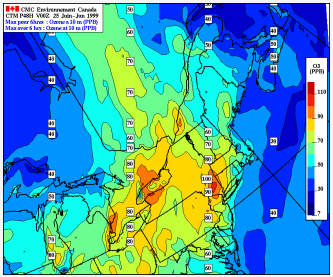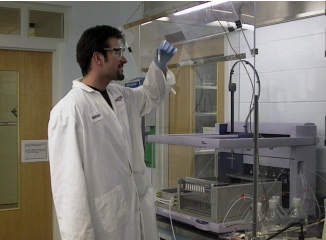Air Quality Research (AQRB)AQRB Home PageContact Information The Five Main Air Quality Issues:

Air quality research focuses on the chemistry of the atmosphere and how it is changing over time. Research is conducted to better understand how these atmospheric chemical changes affect the physical behaviour of the atmosphere, including the transport, transformation and deposition of atmospheric pollutants. The Air Quality Research branch provides the scientific basis for policy development, air quality predictions, and strategies to minimise the potential negative impacts of these atmospheric pollutants on human and natural ecosystem health. The research involves long-term monitoring of atmospheric constituents such as stratospheric ozone, acid rain, photochemical smog, greenhouse gases, hazardous air pollutants, and particulate matter. It also involves extensive field experiments for process studies, and the development of numerical modelling techniques for air quality and environmental predictions. The Air Quality and Research Branch Consists of Four Divisions:1. Experimental Studies Division (ARQX)Studies the photochemical balance of the stratosphere. 
The MANTRA (Middle Atmosphere Nitrogen TRend Assessment) This balloon mission was a research project to investigate changes in the odd-nitrogen budget of the stratosphere. 2. Measurements and Analysis Research Division (ARQM)Conducts long-term measurements to determine the long-term trends and variability of trace gases in the atmosphere, and the impact of human activities on the atmosphere. 
The Alert, NT, High Arctic Global Atmospheric Watch Observatory 3. Modelling and Integration Research Division (ARQI)Carries out modelling research on the transport, transformation and removal of pollutants by the atmosphere. 
Surface ozone prediction at 10 metres. (Ozone scale in parts per billion) 4. Processes Research Division (ARQP)Conducts research on the physical, biological and chemical processes that determine the chemistry of the atmosphere. 
The Organics Analysis Lab in the Meteorological Service of Canada's Andrew Thompson Laboratory Building in Downsview, ON. Depicted here is one of the steps in the analysis of Polycyclic Aromatic Hydrocarbons (PAHs) from the Great Lake's Region.
Created :
2002-08-21
Modified :
2002-12-18
Reviewed :
2002-12-18
Url of this page : http://www.msc.ec.gc.ca
/acsd/aqrb/index_e.html The Green LaneTM, |
The default navigational mode of this site requires either [MSIE 4+], [Netscape 6+], [Opera 5+] or equivalent with JavaScript enabled. If you can not upgrade your browser, or can not enable JavaScript, please use the [text-only] version of this site.